Lebanese Druze
Lebanese Druze (Arabic: دروز لبنان, romanized: durūz lubnān) are Druze people with Lebanese citizenship. The Druze faith is a monotheistic and Abrahamic religion, and an ethnoreligious[1] esoteric group originating from the Near East who self identify as unitarians (Arabic: موحدين, romanized: muwaḥḥidīn).[2]
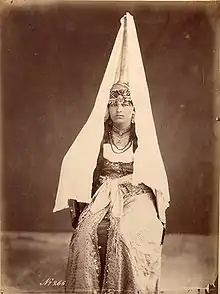 | |
| Languages | |
|---|---|
| Vernacular: Lebanese Arabic | |
| Religion | |
| Druze |
The Lebanese Druze people are believed to constitute about 5.2 percent[3] of the total population of Lebanon and have around 1.5 million members worldwide.[4] The Druze, who refer to themselves as al-Muwahhideen, or "believers in one God," are concentrated in the rural, mountainous areas east and south of Beirut.[3] Lebanon has the world's second largest Druze population, after Syria.
Under the Lebanese political division (Parliament of Lebanon Seat Allocation) the Druze community is designated as one of the five Lebanese Muslim communities in Lebanon (Sunni, Shia, Druze, Alawi, and Ismaili), even though the Druze are no longer considered Muslim.[5][6][7] Lebanon's constitution was intended to guarantee political representation for each of the nation's ethno-religious groups.[8]
The Maronite Catholic and the Druze founded modern Lebanon in the early eighteenth century, through the ruling and social system known as the "Maronite-Druze dualism" in Mount Lebanon Mutasarrifate.[9] Under the terms of an unwritten agreement known as the National Pact between the various political and religious leaders of Lebanon, the Chief of the General Staff must be a Druze.[10]
History
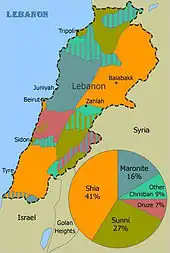
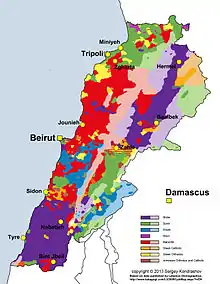
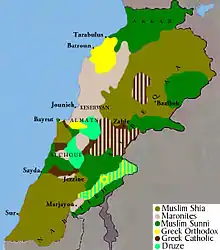
The Druze faith does not follow the Five Pillars of Islam, such as fasting during the month of Ramadan, and making a pilgrimage to Mecca.[11][12] The Druze beliefs incorporate elements of Ismailism, Gnosticism, Neoplatonism and other philosophies. The Druze call themselves Ahl al-Tawhid "People of Unitarianism or Monotheism" or "al-Muwaḥḥidūn."
"The Druze follow a lifestyle of isolation where no conversion is allowed, neither out of, or into, the religion. When Druze live among people of other religions, they try to blend in, in order to protect their religion and their own safety. They can pray as Muslims, or as Christians, depending on where they are. This system is apparently changing in modern times, where more security has allowed Druze to be more open about their religious belonging."[11]
The Tanukhids inaugurated the Druze community in Lebanon when most of them accepted and adopted the new message that was being preached in the 11th century, due to their leaderships close ties with then Fatimid ruler Al-Hakim bi-Amr Allah.[13]
The relationship between the Druze and Christians in Lebanon has been characterized by harmony and coexistence,[14][15][16][17] with amicable relations between the two groups prevailing throughout history, with the exception of some periods, including 1860 Mount Lebanon civil war.[18][19]
Historically the relationship between the Druze and Muslims has been characterized by intense persecution.[20][21][22] The Druze faith is often classified as a branch of Isma'ili. Even though the faith originally developed out of Ismaili Islam, most Druze do not identify as Muslims,[23][24][25] and they do not accept the five pillars of Islam.[26] The Druze have frequently experienced persecution by different Muslim regimes such as the Shia Fatimid Caliphate,[27] Sunni Ottoman Empire,[28] and Egypt Eyalet.[29][30] The persecution of the Druze included massacres, demolishing Druze prayer houses and holy places and forced conversion to Islam.[31] Those were no ordinary killings in the Druze's narrative, they were meant to eradicate the whole community according to the Druze narrative.[32]
The Druze community in Lebanon played an important role in the formation of the modern state of Lebanon, and even though they are a minority they play an important role in the Lebanese political scene. Before and during the Lebanese Civil War (1975–90), the Druze were in favor of Pan-Arabism and Palestinian resistance represented by the PLO. Most of the community supported the Progressive Socialist Party formed by their leader Kamal Jumblatt and they fought alongside other leftist and Palestinian parties against the Lebanese Front that was mainly constituted of Christians. After the assassination of Kamal Jumblatt on 16 March 1977, his son Walid Jumblatt took the leadership of the party and played an important role in preserving his father's legacy after winning the Mountain War and sustained the existence of the Druze community during the sectarian bloodshed that lasted until 1990.
In August 2001, Maronite Catholic Patriarch Nasrallah Boutros Sfeir toured the predominantly Druze Chouf region of Mount Lebanon and visited Mukhtara, the ancestral stronghold of Druze leader Walid Jumblatt. The tumultuous reception that Sfeir received not only signified a historic reconciliation between Maronites and Druze, who fought a bloody war in 1983–84, but underscored the fact that the banner of Lebanese sovereignty had broad multi-confessional appeal[33] and was a cornerstone for the Cedar Revolution in 2005. Jumblatt's post-2005 position diverged sharply from the tradition of his family. He also accused Damascus of being behind the 1977 assassination of his father, Kamal Jumblatt, expressing for the first time what many knew he privately suspected. The BBC describes Jumblatt as "the smartest leader of Lebanon's most powerful Druze clan and heir to a leftist political dynasty".[34] The second largest political party supported by Druze is the Lebanese Democratic Party led by Prince Talal Arslan, the son of Lebanese independence hero Emir Majid Arslan.
On May 10, 2008 as part of the 2008 Conflict, clashes occurred between Hezbollah forces and Druze militias in their mountain resulting is casualties on both sides.[35] The clashes started in Aytat, near Kayfoun and soon expanded to cover many spots in Mount Lebanon including Baysur, Shuweifat and Aley. Most of the fighting was concentrated on Hill 888. After negotiations a ceasefire was called in from outside the country before Hezbollah could call in artillery support. Releases from Hezbollah leaders in 2016 stated that bombing the mountain with close-range artillery from the South and longer-ranged artillery from Syria were both an option and greatly considered.[36]
Lebanese Christians and Druze became a genetic isolate in the predominantly Islamic world.[37]
A number of the Druze embraced Christianity, such as some of Shihab dynasty members,[38] as well as the Abi-Lamma clan,[39] and Khazen family.[40] During the nineteenth and twentieth centuries, Protestant missionaries established schools and churches in Druze strongholds, with some Druze converting to Protestant Christianity;[41] yet they did not succeed to convert Druze to Christianity en masse. On the other hand, many Druze immigrants to the United States converted to Protestantism, becoming communicants of the Presbyterian or Methodist Churches.[42][43]
Demographics

The Druze are concentrated in the rural, mountainous areas east and south of Beirut.[3] The Lebanese Druze are estimated to constitute 5.2 percent of Lebanon's population.[3] They live in 136 villages in Hasbaya, Rashaya, Chouf, Aley, Marjeyoun and Beirut,[44] and they constitute the majority of the population in the city of Aley, Baakleen, Hasbaya and Rashaya.[44] The Druze make up more than half of the population of the Aley District, and they constitute about a third of the residents of the Rachaya District, and they constitute about the quarter of residents of the Chouf District and the Matn District.[45]
Notable people
-2.png.webp) | 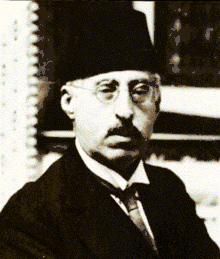 |  |  |  |  | 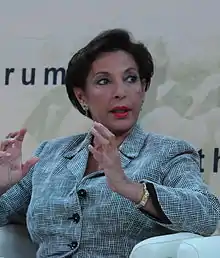 |  |
- Fakhr-al-Din II (1572–1635), a Druze prince and an early leader of the Emirate of Chouf.
- Emir Shakib Arslan (1869–1946), a Druze prince and notable Islamic scholar.
- Emir Majid Arslan (1908–1983), a Druze leader and head of the Arslan feudal Druze ruling family, and he is the leader of the final independence movement that caused the independence of Lebanon.
- Kamal Jumblatt (1917–1977), a prominent Lebanese progressive socialist politician.
- Casey Kasem (1932–2014), Lebanese-American born in Detroit radio personality/DJ
- Nabil Kanso (born 1946), a Lebanese-American painter.
- Akram Chehayeb (born 1947), a Lebanese politician, member of parliament,and Minister of Agriculture.
- Walid Jumblatt (born 1949), a Lebanese politician and the current leader of the Progressive Socialist Party (PSP).
- Raghida Dergham (born 1953), a Lebanese-American journalist based in New York.
- Ghazi Aridi (born 1954), a Lebanese politician, and member of parliament.
- Samir Kuntar (1962–2015), member of the Palestine Liberation Front representing Hezbollah
- Emir Talal Arslan (born 1965), Lebanese politician and the head of the mostly Druze Lebanese Democratic Party.
- Ahmad Abou Zaki (1941-2014), General in the Lebanese Internal Security Forces, mostly known of his great Ethics and Integrity
- Mona Abou Hamze (born 1972), TV presenter.
- Amal Clooney (born 1978), a London-based British-Lebanese lawyer, activist, and author. (Druze father and Sunni mother.)
- Ramy Ayach (born 1980), singer/ popstar.
- Raya Meddine, actress.
- Manal Abdel Samad, former Information Minister of Lebanon
See also
| Part of a series on
Druze |
|---|
 |
|
- Chouf District
- Druze
- Shia Islam in Lebanon
- Sunni Islam in Lebanon
- Maronite Christianity in Lebanon
- Christianity in Lebanon
- Roman Catholicism in Lebanon
- Melkite Christianity in Lebanon
- Eastern Orthodox Christianity in Lebanon
- Protestantism in Lebanon
- Religion in Lebanon
- Lebanese Democratic Party
- Progressive Socialist Party
References
- Chatty, Dawn (2010-03-15). Displacement and Dispossession in the Modern Middle East. Cambridge University Press. ISBN 978-0521817929.
- Doniger, Wendy (1999). Merriam-Webster's Encyclopedia of World Religions. Merriam-Webster, Inc. ISBN 0877790442.
- Lebanon 2015 International Religious Freedom Report U.S. Department of State. Retrieved on 2019-04-23.
- Sewell, Abby (2017-09-15). "Finding a life partner is hard enough. For those of the Druze faith, their future depends on it". GulfNews. Retrieved 2018-09-16.
- James Lewis (2002). The Encyclopedia of Cults, Sects, and New Religions. Prometheus Books. Retrieved 13 May 2015.
- https://books.google.ca/books?id=wXO8AAAAQBAJ&pg=PA97 Lebanon Country Study Guide Volume 1 Strategic Information and Developments
- De McLaurin, Ronald (1979). The Political Role of Minority Groups in the Middle East. Michigan University Press. p. 114. ISBN 9780030525964.
Theologically, one would have to conclude that the Druze are not Muslims. They do not accept the five pillars of Islam. In place of these principles the Druze have instituted the seven precepts noted above..
- Encyclopedia of the Peoples of Africa and the Middle East. 2009. ISBN 9781438126760.
- Deeb, Marius (2013). Syria, Iran, and Hezbollah: The Unholy Alliance and Its War on Lebanon. Hoover Press. ISBN 9780817916664.
the Maronites and the Druze, who founded Lebanon in the early eighteenth century.
- United Nations Development Programme : Programme on Governance in the Arab Region : Elections : Lebanon Archived 2011-07-18 at the Wayback Machine. Retrieved 25 January 2010.
- "Druze". druze.org.au. 2015. Archived from the original on 2016-02-14.
- James Lewis (2002). The Encyclopedia of Cults, Sects, and New Religions. Prometheus Books. Retrieved 13 May 2015.
- William Harris (19 Jul 2012). Lebanon: A History, 600-2011 (illustrated ed.). Oxford University Press. p. 46. ISBN 9780195181111.
- Hazran, Yusri (2013). The Druze Community and the Lebanese State: Between Confrontation and Reconciliation. Routledge. p. 32. ISBN 9781317931737.
the Druze had been able to live in harmony with the Christian
- Artzi, Pinḥas (1984). Confrontation and Coexistence. Bar-Ilan University Press. p. 166. ISBN 9789652260499.
.. Europeans who visited the area during this period related that the Druze "love the Christians more than the other believers," and that they "hate the Turks, the Muslims and the Arabs [Bedouin] with an intense hatred.
- CHURCHILL (1862). The Druzes and the Maronites. Montserrat Abbey Library. p. 25.
..the Druzes and Christians lived together in the most perfect harmony and good-will..
- Hobby (1985). Near East/South Asia Report. Foreign Broadcast Information Service. p. 53.
the Druzes and the Christians in the Shuf Mountains in the past lived in complete harmony..
- Fawaz, L.T. (1994). An Occasion for War: Civil Conflict in Lebanon and Damascus in 1860. University of California Press. ISBN 9780520087828. Retrieved 2015-04-16.
- Vocke, Harald (1978). The Lebanese war: its origins and political dimensions. C. Hurst. p. 10. ISBN 0-903983-92-3.
- Swayd, Samy (2015). Historical Dictionary of the Druzes. Rowman & Littlefield. p. 132. ISBN 9781442246171.
Some Muslim rulers and jurists have advocated the persecution of members of the Druze Movement beginning with the seventh Fatimi Caliph Al-Zahir, in 1022. Recurring period of persecutions in subsequent centuries ... failure to elucidate their beliefs and practices, have contributed to the ambiguous relationship between Muslims and Druzes
- K. Zartman, Jonathan (2020). Conflict in the Modern Middle East: An Encyclopedia of Civil War, Revolutions, and Regime Change. ABC-CLIO. p. 199. ISBN 9781440865039.
Historically, Islam classified Christians, Jews, and Zoroastrians as protected “People of the Book,” a secondary status subject to payment of a poll tax. Nevertheless, Zoroastrians suffered significant persecution. Other religions such as the Alawites, Alevis, and Druze often suffered more.
- Layiš, Aharôn (1982). Marriage, Divorce, and Succession in the Druze Family: A Study Based on Decisions of Druze Arbitrators and Religious Courts in Israel and the Golan Heights. BRILL. p. 1. ISBN 9789004064126.
the Druze religion, though originating from the Isma'lliyya, an extreme branch of the Shia, seceded completely from Islam and has, therefore, experienced periods of persecution by the latter.
- "Are the Druze People Arabs or Muslims? Deciphering Who They Are". Arab America. Arab America. 8 August 2018. Retrieved 13 April 2020.
- J. Stewart, Dona (2008). The Middle East Today: Political, Geographical and Cultural Perspectives. Routledge. p. 33. ISBN 9781135980795.
Most Druze do not consider themselves Muslim. Historically they faced much persecution and keep their religious beliefs secrets.
- Yazbeck Haddad, Yvonne (2014). The Oxford Handbook of American Islam. Oxford University Press. p. 142. ISBN 9780199862634.
While they appear parallel to those of normative Islam, in the Druze religion they are different in meaning and interpretation. The religion is consider distinct from the Ismaili as well as from other Muslims belief and practice... Most Druze consider themselves fully assimilated in American society and do not necessarily identify as Muslims..
- De McLaurin, Ronald (1979). The Political Role of Minority Groups in the Middle East. Michigan University Press. p. 114. ISBN 9780030525964.
Theologically, one would have to conclude that the Druze are not Muslims. They do not accept the five pillars of Islam. In place of these principles the Druze have instituted the seven precepts noted above..
- Parsons, L. (2000). The Druze between Palestine and Israel 1947–49. Springer. p. 2. ISBN 9780230595989.
With the succession of al-Zahir to the Fatimid caliphate a mass persecution (known by the Druze as the period of the mihna) of the Muwaḥḥidūn was instigated ...
- C. Tucker, Spencer C. (2019). Middle East Conflicts from Ancient Egypt to the 21st Century: An Encyclopedia and Document Collection [4 volumes]. ABC-CLIO. pp. 364–366. ISBN 9781440853531.
- Taraze Fawaz, Leila. An occasion for war: civil conflict in Lebanon and Damascus in 1860. p.63.
- Goren, Haim. Dead Sea Level: Science, Exploration and Imperial Interests in the Near East. p.95-96.
- C. Tucker, Spencer C. (2019). Middle East Conflicts from Ancient Egypt to the 21st Century: An Encyclopedia and Document Collection [4 volumes]. ABC-CLIO. p. 364. ISBN 9781440853531.
- Zabad, Ibrahim (2017). Middle Eastern Minorities: The Impact of the Arab Spring. Routledge. ISBN 9781317096726.
- Nasrallah Boutros Sfeir, Meib, May 2003, archived from the original (dossier) on July 20, 2009
- "Who's who in Lebanon". BBC News. 14 March 2005. Retrieved 13 August 2011.
- "Saturday's live coverage of the war in Lebanon". Ya Libnan. Archived from the original on 2008-06-12. Retrieved 2008-12-24.
- Kandy Ringer. "Lebanon's Fighting Spreads to Druze Heartland". BBC News. Archived from the original on May 14, 2008. Retrieved 2008-12-24.
- Haber et al. 2013. Quote:1-"We show that religious affiliation had a strong impact on the genomes of the Levantines. In particular, conversion of the region's populations to Islam appears to have introduced major rearrangements in populations' relations through admixture with culturally similar but geographically remote populations, leading to genetic similarities between remarkably distant populations like Jordanians, Moroccans, and Yemenis. Conversely, other populations, like Christians and Druze, became genetically isolated in the new cultural environment. We reconstructed the genetic structure of the Levantines and found that a pre-Islamic expansion Levant was more genetically similar to Europeans than to Middle Easterners."
2-"The predominantly Muslim populations of Syrians, Palestinians and Jordanians cluster on branches with other Muslim populations as distant as Morocco and Yemen."
3-Lebanese Christians and all Druze cluster together, and Lebanese Muslims are extended towards Syrians, Palestinians, and Jordanians, which are close to Saudis and Bedouins." - Mishaqa, p. 23.
- Gábor Ágoston; Bruce Alan Masters (2009-01-01). Encyclopedia of the Ottoman Empire. Infobase Publishing. p. 530. ISBN 978-1-4381-1025-7. Retrieved 2013-05-25.
- Matti Moosa, The Maronites in History, p. 283. Quote
- A. Kayyali, Randa (2006). The Arab Americans. Greenwood Publishing Group. p. 21. ISBN 9780313332197.
some Christians (mostly from the Orthodox faith), as well as Druze, converted to Protestantism...
- A. Kayyali, Randa (2006). The Arab Americans. Greenwood Publishing Group. p. 21. ISBN 9780313332197.
Many of the Druze have chosen to deemphasize their ethnic identity, and some have officially converted to Christianity.
- Hobby, Jeneen (2011). Encyclopedia of Cultures and Daily Life. University of Philadelphia Press. p. 232. ISBN 9781414448916.
US Druze settled in small towns and kept a low profile, joining Protestant churches (usually Presbyterian or Methodist) and often Americanizing their names..
- تعرف على طائفة "الموحدين العرب" الدروز, BBC
- Barakat, Halim (2011). Lebanon in Strife: Student Preludes to the Civil War. University of Texas Press. ISBN 9780292739819.
the Druzes make up almost half the district, of Aley, one third of Rashaya, and more than a quarter of Shuf and Matn...